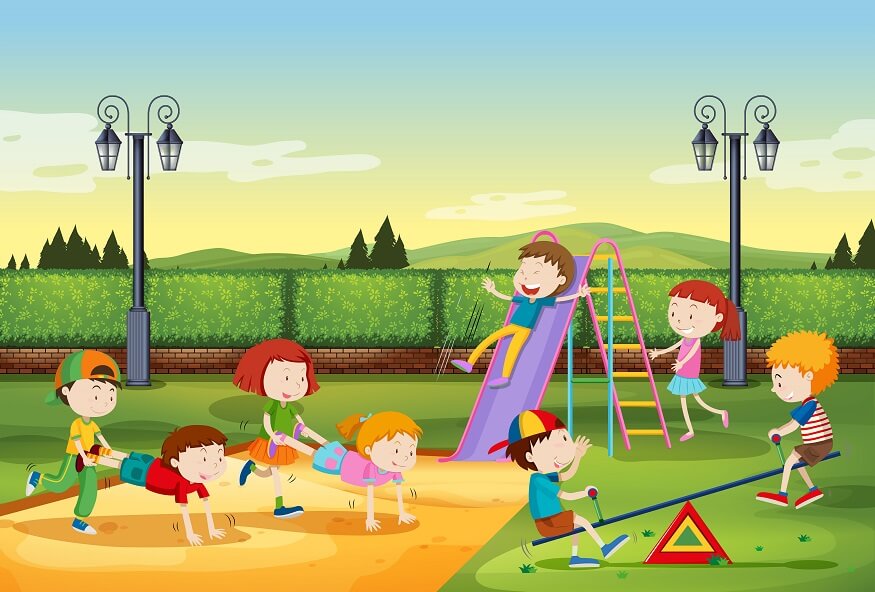Guidelines, Precautions, and Significance of Playground Safety for Children

Playground safety is paramount in ensuring the well-being of children during recreational activities. It refers to the measures and guidelines implemented to protect children from potential hazards while engaging in recreational activities.
Playground safety involves creating an environment where children can play freely without compromising their well-being. It is crucial for preventing injuries and fostering a secure atmosphere for children to develop physically and socially. Adherence to safety rules and precautions, such as age-appropriate equipment, regular inspections, and proper surfacing, is imperative. These safety measures in a playground minimise the risk of accidents like falls, cuts, or collisions. Vigilance from caregivers and educators reinforces the importance of playground safety, promoting a balance between fun and protection in children’s play environments.
The Significance of Playground Safety for Children
A.Physical and Mental Benefits of Playgrounds:
- Physical Development: Playgrounds facilitate the development of gross motor skills in children as they engage in activities like running, jumping, and climbing. Various equipment like swings and slides contribute to the enhancement of coordination and balance.
- Social Interaction: Playgrounds serve as social hubs where children learn to interact, share, and collaborate with their peers. Group play fosters the development of social skills, including communication and conflict resolution.
- Cognitive Stimulation: Playgrounds offer a multisensory environment that stimulates cognitive development through problem-solving and decision-making. Imaginative play on equipment like playhouses enhances creativity and cognitive flexibility.
- Statistics on Playground Accidents:
- Common Incidents: Falls are the leading cause of playground injuries, accounting for a significant percentage of accidents. Other common incidents include collisions, entanglement in equipment, and impact injuries.
- Age-Related Trends: Younger children are more prone to injuries on playgrounds, often due to their developing motor skills and limited risk perception. Older children may experience accidents related to riskier activities or misuse of equipment.
- Importance of Supervision: Adult supervision on playgrounds can prevent accidents and respond promptly if injuries occur. Adequate playground safety measures, such as soft ground surfaces and well-maintained equipment, contribute to accident prevention.
- The Role of Playground Safety in Child Development:
- Preventive Measures: Implementing safety guidelines, such as age-appropriate equipment and proper surface materials, reduces the risk of injuries. Regular maintenance checks and repairs ensure that the playground remains a safe environment.
- Promoting Confidence: A safe playground fosters confidence in children, encouraging them to explore and engage in physical activities without excessive fear of injury. Positive experiences on the playground contribute to the overall well-being and mental health of children.
- Long-Term Impact: A commitment to playground safety contributes to healthy physical and mental development, laying the foundation for an active and confident lifestyle in adulthood. Public awareness and education about playground safety play a crucial role in creating a safer environment for children to thrive.
- Location and Surroundings
- Proximity to Residential Area: Opt for playgrounds located near residential areas to ensure a sense of community and increased supervision. Proximity facilitates easy access for families, promoting regular usage and fostering a safer environment.
- Accessibility and Parking: Choose a safe playground with convenient access points and ample parking facilities. Easy accessibility encourages families to visit regularly, while sufficient parking reduces congestion and ensures a safer drop-off and pick-up experience.
- Inspection of Surrounding Environment: Prioritise playgrounds situated in well-maintained and clean surroundings. Regular inspections of the environment help identify and address potential safety hazards, promoting a secure play space for children.
- Playground Equipment
- Age-Appropriate Equipment: Select playgrounds equipped with age-appropriate structures to cater to the developmental needs of children. Age-specific equipment minimises the risk of injuries and ensures a more enjoyable and beneficial play experience.
- Well-Maintained Structures: Opt for playgrounds where equipment is regularly inspected and well-maintained. Regular maintenance prevents the development of hazards such as sharp edges, rust, or worn-out surfaces, enhancing overall safety.
- Compliance with Safety Standards: Prioritise playgrounds that adhere to established safety standards and guidelines. Playground safety for children ensures that the equipment meets safety regulations, reducing the likelihood of accidents and injuries during play.
- General Playground Safety Guidelines
- Adult Supervision: Ensure qualified adults supervise the playground to oversee children’s activities. Monitor interactions to prevent accidents and enforce safety rules.
- Appropriate Attire: Encourage children to wear suitable clothing and footwear for play to avoid injuries. Remove any accessories that might pose a risk during physical activities.
- No Rough Play: Emphasise the importance of gentle and cooperative play. Discourage pushing, shoving, or any behaviour that could lead to accidents.
- Equipment-Specific Safety Measures
- Swings: Teach proper swinging techniques, such as sitting or kneeling, and holding onto the swing securely. Establish designated areas for swinging to avoid collisions with other equipment.
- Slides: Instruct children to go down the slide feet first, sitting up straight. Ensure the slide is clear before allowing another child to descend.
- Climbing Structures: Enforce climbing rules, such as using both hands and feet and staying within designated areas. Regularly inspect climbing structures for any loose or damaged components.
- Surface Safety
- Importance of Soft Surfacing: Prioritise playgrounds with soft surfaces like rubber mulch, sand, or engineered wood chips to cushion falls. Educate caregivers on the significance of impact-absorbing materials.
- Regular Maintenance of Ground Cover: Conduct routine inspections of the ground cover to identify and address any hazards promptly. Repair or replace damaged surfaces to maintain a safe play environment.
- Avoidance of Hard Surfaces: Design playground layouts to minimise the proximity of equipment to hard surfaces. Discourage children from playing on asphalt or concrete areas surrounding the playground.
How to Choose a Safe Playground?
Here are some tips for choosing a safe playground for your child.
Common Playground Safety Rules and Measures
Educating Children on Playground Safety
Besides ensuring playground safety, educate children on the importance of proper equipment usage, understanding boundaries, and respectful play. Emphasise the significance of checking for hazards and reporting them promptly. Teach basic first aid, fostering a culture of responsibility.
Billabong High International School integrates these values into its holistic education approach, cultivating not just academic excellence but also the physical and social development of each child. Through a dedicated focus on playground safety for children, Billabong High creates a secure environment where children can learn, play, and grow, ensuring a wholesome educational experience.








